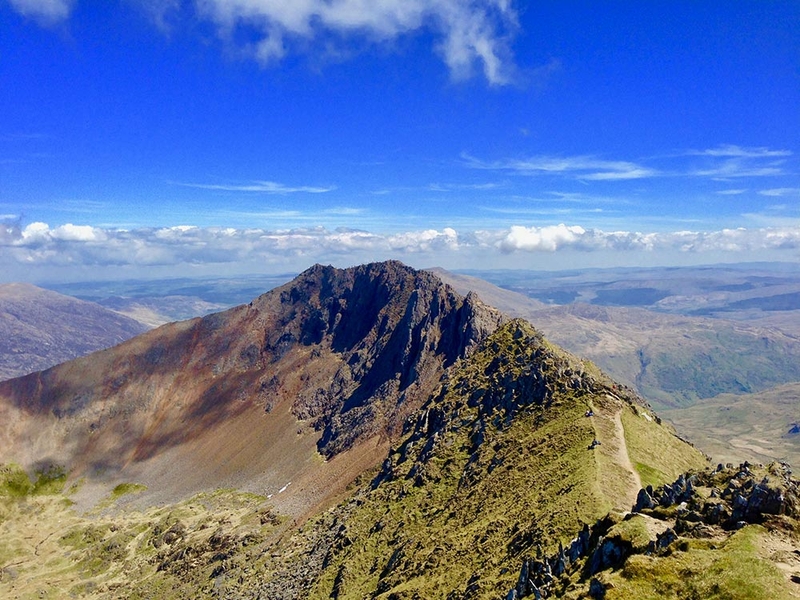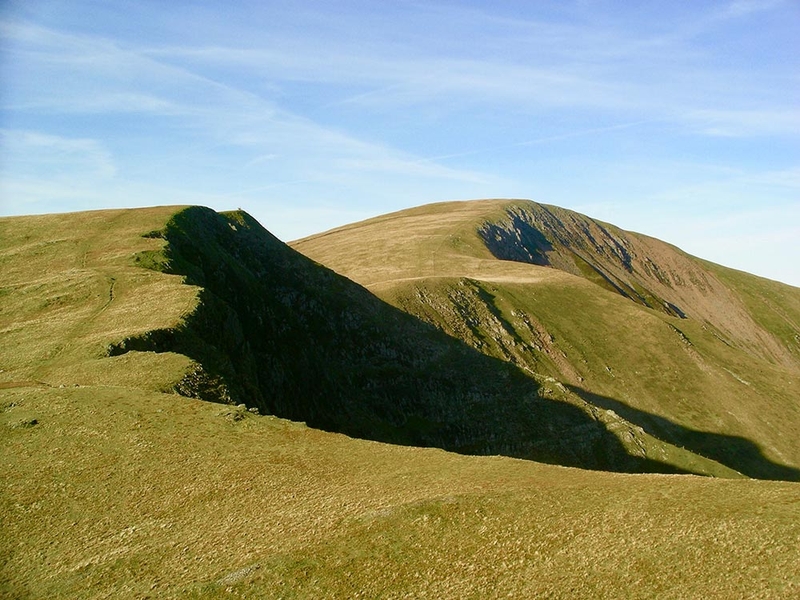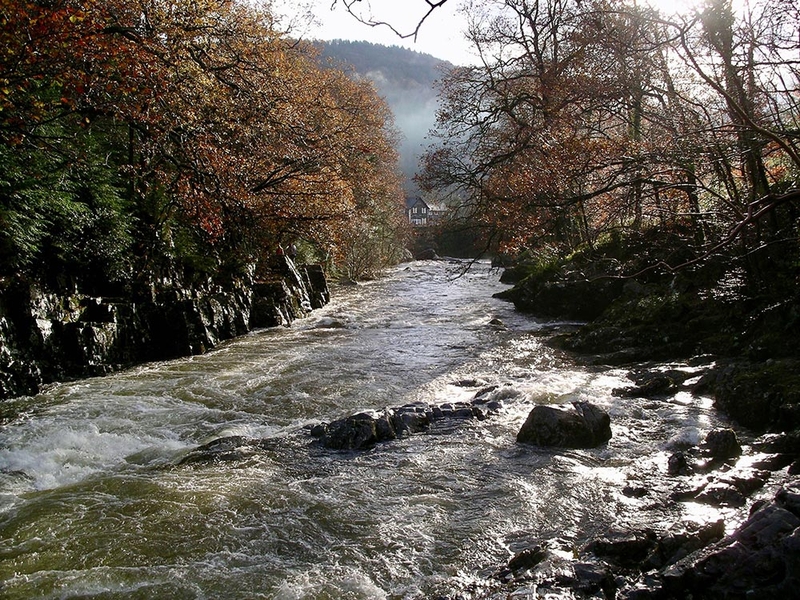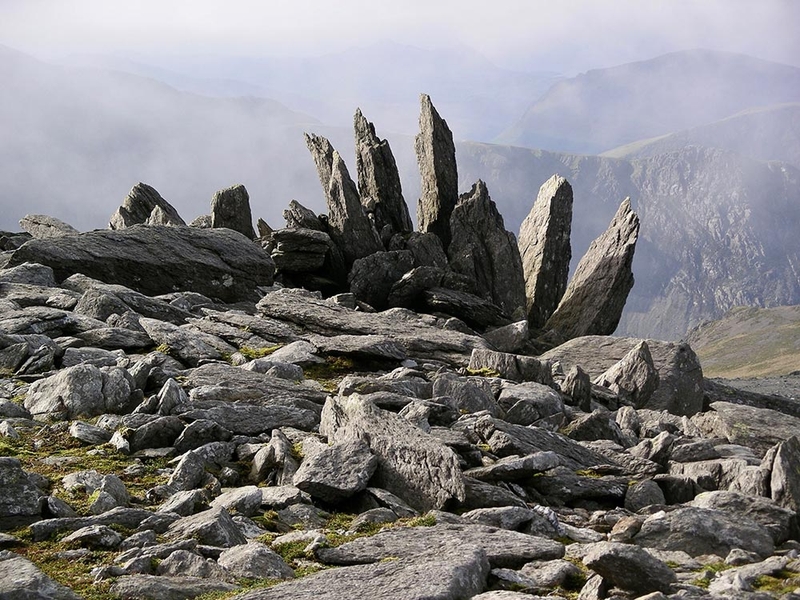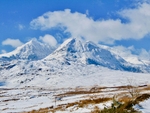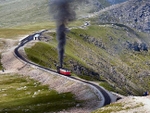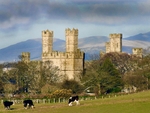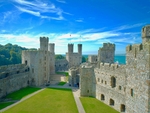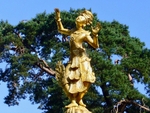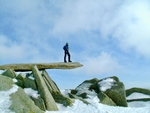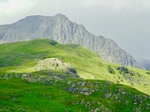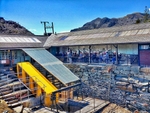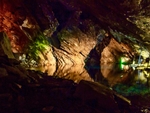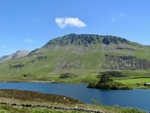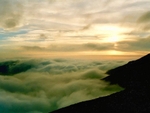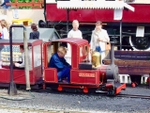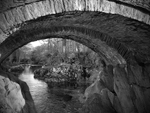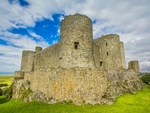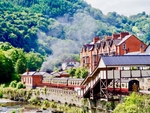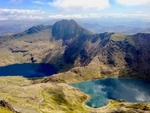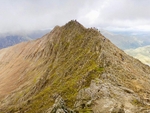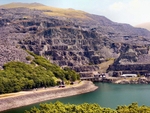1. Mount Snowden
The 1085-metre Mount Snowdon is Wales' highest peak and the most popular mountain in the UK.
Legend has it that Snowdon is the burial site of the giant ogre, Rhita, vanquished by King Arthur. Its summit can be reached by a variety of fairly well marked paths, or, for those who want to take it easy, by the Snowdon Mountain Railway.
The views are spectacular. On exceptionally clear days, they extend not only to the nearby mountains, valleys and lakes but also to the Peak District, the South Pennines, the Isle of Man, Ireland and Scotland.
The summit is also home to Hafod Eryri, a curved granite cafe and visitor centre opened in 2009 in place of a 1930s building once described by Prince Charles (the Prince of Wales) as the:
"highest slum in Europe."
Designed by Ray Hole, Hafod Eryri attracts 500,000 each year. Unfortunately, due to essential work on upper mountain tracks, Hafod Eryri will be closed in 2022, and is due to reopen for 2023. Clogwyn Station, three quarters of the way up Snowden will be the final destination point for the Mount Snowden railway service.
The routes up Snowdon
The Pyg and Miners' tracks, which both start from the Pen-y-Pass car park (359 metres, grid reference 647556), are the most popular paths up Snowdon. The Miners' track is slightly easier, starting off more gently and winding around three pretty lakes before the steeper ascent to the summit; the Pyg track gains height more quickly before re-joining the Miners' track for the final section of ascent.
The longer Watkins Path starts from the Nantgwynant car park (60 metres, grid reference 628507), and passes some pretty waterfalls on its way to the top. Contrast the easy Llanberis Path, a dull 10-mile plod alongside the railway line.
Finally there are the Snowdon Ranger (7 miles, popular in winter) and Rhyd Ddu Paths (8 miles, the least used route).
How long does it take?
For those of average fitness the walk (up and down) takes between 4 and 5 hours on the Pyg and Miners' tracks and the Snowdon Ranger Path and about 5 to 6 hours on the Watkins, Ryyd Ddu and Llanberis paths.
The Snowdon Railway
The Snowdon Mountain Railway, a masterpiece of Victorian engineering dating from 1896, departs from Llanberis; it offers 4.7 mile/2.5 hour round-trips to the summit. The diesel or steam powered journies (steam costs more!) offer great mountain views, as you pass lakes, over two viaducts and past wildlife that includes goats, sheep and (very occasionally) polecats!
when? The summit can be reached on foot all year round, though inexperienced walkers should only attempt the mountain in good weather. Usual mountain precautions should be taken. The Snowdon Mountain Railway runs to the summit from mid-April to October.
£$€¥ Walking in the mountains is free. Parking in the Pen-y-Pass car park costs £18 for an 8 hour pass (Grid Ref: SH647555; SatNav: Lat 53.079533 // Long -4.021304; Postcode: LL55 4NU). Space is limited and other options are the quieter Watkins Path car park and the Nant Peris Park and Ride.
The Snowdon Mountain Railway charges £35 for a return adult ticket, and £25 for a return children's ticket for travel on their diesel locomotives. The prices go up to £45 and £35 for the 'Heritage Steam Experience' (May 2022). Early bird discounts are available for those taking the 9am service!
2. Caernarfon Castle
The construction of Caernarfon Castle commenced on the orders of Edward I in 1283.
The brief was to create as imposing a structure as possible as a symbol of the new English rule in Wales.
Caernarfon's architect, Master James of St George, did not disappoint: the Castle is fortified with a series of murder holes (through which scolding liquid could be poured on attackers) and advanced arrow slits (giving archers defending the castle maximum range of vision and protection).
Interesting fact ...
When Prince Charles becomes king, it is expected that Prince William will be invested as Prince of Wales at Caernarfon Castle.
The Castle's walls are often said to have been modelled on the walls of the city of Constantinople. And its Eagle Tower, complete with grand lodgings for Wales' first justiciar (ie chief minister), is the jewel in the Castle's crown.
It boasts three substantial turrets and a water gate on its basement level (for access to the castle from the River Seiont).
These days, Caernarfon's Queen's Tower houses the Royal Welsh Fusiliers Museum.
The castle in history
An army led by Owain Glyndwr was repelled in 1404 by a garrison of only 28 men, and Caernarfon resisted three sieges during the English civil war.
Caernarfon Castle soon became, and remained, the most important in Wales. Thus, Edward I made sure his first son, the first Prince of Wales, was born here in 1284.
More recently, the future Edward VIII was invested as Prince of Wales here in 1911, as was Prince Charles in 1969. Caernarfon was named as part of a UNESCO world heritage site in 1986, reflecting its status as one of the world's finest surviving medieval castles.
Exploring Caernarfon
Caernarfon is a pretty town in its own right, boasting a large market square (with a carousel in summer months), a pretty harbour, a range of boutique shops and eateries on Palace Street, and one of the best pubs in Snowdonia in the Black Boy Inn (offering fantastic pub grub in a building dating from 1522).
where? Caernarfon Castle, Castle Ditch, Caernarfon, Gwynedd LL55 2AY T: 01286 677 617. There is ample reasonably priced car parking in the town. MAP
when? Mar - Jun: 9.30-17.00; Jul - Aug: 09.30-18.00; Sep - Oct: 09.30-17.00; Nov - Feb: 10.00-16.00. Closed: 24-26 Dec, 1 Jan.
£$€¥ Adults: £11.10, Children: £7.80, Seniors: £10.60, Family Ticket: £36.60 (2 adults, 3 under-16s) (May 2022).
3. Waterfalls
Snowdonia boasts a number of impressive waterfalls, best visited after heavy rain—a not infrequent occurrence in this part of the world!
Of particular note are Swallow and Conwy Falls, both close to Betws-y-Coed, and Aber Falls, found between Bangor and Llandudno.
Swallow and Conwy Falls
Swallow Falls are found on the river Llugwy, and is the longest continuous waterfall in Wales. Conwy Falls are found at the confluence of the Conwy and Machno, and feature a fish pass to assist sea trout and salmon trying to swim upstream to their breeding grounds.
Both sets of falls are often impressively powerful, are found in peaceful wooded gorges, and boast significant wildlife (including ducklings, dippers, wagtails, otters and salmon—which can sometimes be seen trying to ascend the falls in August).
The Conwy Falls attracted national press attention in summer 2016, following plans to install a £12 million hydroelectric scheme on the River Conwy. Some claimed that the scheme would reduce the flow of water to a trickle.
Aber Falls
Aber Falls, located close to the pretty village of Abergwyngregyn, are found on the Afon Goch river. Perhaps the most impressive of Snowdonia's waterfalls, they are formed of igneous rock in the foothills of the Carneddau and are some 37-metres high. The Bont Newydd car park (with clean toilets and a picnic area) is the best place to park, with the walk to Aber Falls taking around 30 minutes.
where? Swallow Falls is found to the west of Betws-y-Coed, at grid reference 763578. Conwy Falls to the south-east, at grid reference 808534. MAP
when? All year round, but the falls are particularly impressive after heavy rainfall.
£$€¥ Entrance to Conway Falls is £1 per person. Whilst Swallow Falls can be accessed for free, entrance fees of £2 are payable at some access points. Parking at Aber Falls costs £5.
4. Portmeirion
Designed and built by Sir Clough Williams-Ellis over 50 years, Portmeirion is a small village on the estuary of the River Dwyryd.
It comprises a collection of vibrant Italiante-designed buildings, lush central park, boutique hotel, sandy beach and 70 acres of grounds.
Best known for its mild climate, peaceful atmosphere and vibrant Mediterranean colours and gardens, Portmeirion is a fantastic destination for a sunny day.
Construction
When Williams-Ellis bought the Portmeirion land in 1925, he had a lot of work to do: the peninsula was derelict and overgrown. He worked between 1926 and 1976, only stopping when he reached the age of ninety.
Some buildings were restored, whist others (such as the 1760 Old Bristol Colonnade) were painstakingly relocated from their original location or designed and built from scratch.
The result is a series of brightly coloured, terracotta-topped buildings, towers, arches, domes and sculptures arranged around a central park (complete with fountains, ponds and giant chess set).
Visiting Portmeirion
Little wonder, then, that Portmeirion attracts over 250,000 visitors annually and is one of Snowdonia's most popular attractions.
Visitors start by wandering along the main cobbled street towards the central park. There are lots of nooks and crannies, viewpoints and balconies to explore en route. You will love the views over the Dwryd estuary and its characterful sandbanks to your left as you walk. Then take in the central plaza and stop for a coffee or ice-cream at one of the various eateries.
A particular joy is Portmeirion's flora, especially its white, blue and red rhododendrons (including the Portmeirion Red Rhododendron, a hydbrid grown here in 1938), azaleas and water lilies.
Lunch
For lunch, we recommend Hotel Portmeirion. Bag an outside table overlooking the estuary for lunch (service starts at 12), with options including sandwiches, light snacks (from £9) and full meals (from £18). We loved the generously-filled crab and prawn baguettes (good value at £11 each).
Portmeirion is also a great place for a picnic.
Interesting fact ...
Portmeirion is also famous for being the location of The Village featured in the cult television show \*\*\*The Prisoner\*\*\*. An annual convention is held here each April. The final episode of \*Cold Feet\* was also filmed here, with Adam (James Nesbitt) scattering the ashes of Rachel (Helen Baxendale) into the estuary.After lunch
After lunch, why not go for a stroll along the sandy beach, or (if you are feeling energetic) complete the well-marked coastal path (1.5 hours) or hilltop loop (1.25 hours).
An alternative way of exploring the Portmeirion estate is to take the land train from the central plaza.
where? Portmeirion is found in the Penrhyndeudraeth community 2 miles south east of Porthmadog. MAP
when? Open 364 days a year (not 25 Dec) from 9.30 am to 5.30pm. Many choose to stay in or close to the village, with options including the Hotel Portmeirion, various other rooms and self-catering cottages around the estate, and the Castell Deudraeth (a gothic-style castle recently converted into a small hotel).
£$€¥ Adults £17; Concessions £13.50; Children (5-15yrs) £10; Under 5s free. A range of family tickets are available. (May 2022)
5. The Glyders
The 994-metre Glyder Fach and 999-metre Glyder Fawr, together the Glyders, are two of the UK's finest mountains.
They offer views of Snowdon and its surrounding mountains to the south-west, the front ridge of the Carneddau to the north-east, and the famous 'Adam and Eve' boulders and cantilever stone. For those looking for adventure, try the optional grade 1 scramble over the imposing Tryfan (915 metres).
where? Start your walk from the car park at the western end of Llyn Ogwen (grid reference 648604). From there, stroll up to and around Llyn Idwal, scramble over the challenging Bristly Ridge (pictured), and onto Glyder Fawr; then follow the ridge for about an hour until you summit Glyder Fach, following bristly ridge down towards Llyn Bochlwyd, and then back to the car park. The circular route takes about 5 hours.
The Front Ridge of the Carnaddau is a classic Welsh walk, taking in three 3000ft peaks, Pen-yr-ole-wen (979m), Carnedd Dafydd (1044m) and Carnedd Llywelyn (1063 metres). The walk also starts from the western end of Llyn Ogwen, with a continuously steep ascent of about 700 metres to the top of Pen-yr-ole-wen.
The effort is worthwhile, with a fine ridge walk leading to Carnedd Dafydd. There is then some descent, past the Black Ladders and Bwlch Cyfrym-drum, before another 100 metres of ascent takes you to the highest point of the walk, Carnedd Llywelyn. Then head east down to Craig yr Isfa (where the walk can be cut short by heading for a tarmacked track leading to the main road).
Feeling hardcore?
For those with more miles in them, continue along a fine ridge to Bwlch Trimarchog, ascend to Pen Llithrig y Wrach, and then descend southwards to Llyn Cowlyd's northern shore. Continue westwards to Pont y Bedol and back to the main road. The full route is 20 kilometres long, involves 1000 metres of ascent, and takes about 7-8 hours.when? The summits can be reached on foot all year round, though inexperienced walkers should only attempt the mountain in good weather. Usual mountain precautions should be taken.
£$€¥ Free. Car parking, spaces permitting, is £4 per day. The car park has a small cafe.
6. The National Slate Museum and Llechwedd Slate Caverns
Slate mining was one of North Wales' principal industries between the early 1800s and the 1960s.
Two of Snowdonia's best attractions are devoted to it.
At the National Slate Museum at Llanberis you can watch craftsmen as they demonstrate traditional skills, see an operational slate workshop (complete with foundry, forge, steam locomotive, and the largest working waterwheel in the country) and a terrace of recreated houses dating from the Golden Age of Slate (1861), the Penrhyn Strike (1901), and the closing of Wales' last quarry (1969).
The Llechwedd Slate Caverns, at Blaenau Ffestiniog, allow visitors to explore the underground world of a slate miner. The Deep Mine Tour lowers visitors 500 feet into the mountain (on Europe's steepest mining cableway), and takes in 10 vast underground caverns and a beautiful underground lake.
The Quarry Explorer takes you on a spectacular off-road adventure as you explore the Llechwedd quarry. You will ascend some of the summits of the man-made slate mountains, up to 1,500 feet above sea level.
These attractions are great things to do on sunny or rainy days.
The Snowdonia Slate Trail
Launched in 2017, the Snowdonia Slate Trail is a loop from Port Penrhyn near Bangor to Capil Curig, Betws-y-Coed, Blaenau Ffestiniog, Beddgelert, Nantlle and back again to Bangor. At 83 miles, this route is for serious walkers only, taking between five and seven days. It is a great option because it takes in some of the tourist hot spots of Snowdonia as well as some lesser-visited parts.
where? The National Slate Museum is in Llanberis, within the Padarn Country Park. The Slate Caverns are half a mile north of Blaenau Ffestiniog on the A470. MAP
when? The National Slate Museum: open daily 10am to 5pm. The Slate Caverns are open all year round, and you can book one of four time slots between 10am and 3pm for the Deep Mine Tour.
£$€¥ Entry to the National Slate Museum is free. The Deep Mine Tour at the Slate Caverns costs between £20 and £23 per person, while group tickets for 4 people costs from £60.
7. Cadair Idris
The 893 metre high Cadair Idris (aka Cader Idris) is one of the most beautiful peaks in the Snowdonia national park.
The 11 kilometre summit ridge also takes in the smaller peaks of Mynyyd Moel (855m), Pen-y-Gader (893m) and Mynydd Pencoed (798m). Quite aside from its beauty, the mountain is steeped in legend. For instance, its name (translated as the Chair of Idris) comes from the tale that it was used by the Welsh giant Idris as a chair for star-gazing.
It is also said that the mountain has several bottomless lakes. And many maintain that anyone who spends a night on the mountain will wake up either a poet or a madman.
where? Grid reference SH711130. There are two main routes up the mountain. The first is the Pony path, a 10 kilometre walk from the car park at Ty-nant (SH697152), involving 888 metres of ascent; this is the easier of the two routes, ascending the mountain's gentler northern slopes. The second route is the circular 10 kilometre Minffordd path, leaving from the Minffordd hotel's car park on the mountain's southern side (SH732115); this route involves 957 metres of ascent with the round trip taking about 6 hours.
when? All year round, though inexperienced walkers should only attempt the mountain in good weather. Usual mountain precautions should be taken.
£$€¥ Free.
8. Betws-y-Coed
Betws-y-coed is a picturesque stone town in the centre of the Snowdonia national park.
The town is made up of the pretty Church of St Mary, various hotels, tea rooms, coffee and outdoor shops and a number of tourist attractions. It is surrounded by a beautiful Gwydyr forest (pictured) and is near the junction of the Llugwy, Conwy and Lledr rivers.
The Pont-y-Pair Bridge
In the centre of Betws is the Pont-y-Pair Bridge, a five-arch stone bridge crossing the River Llugwy. The rapids and waterfalls underneath the bridge are impressive after heavy rain.
In addition, the Pont-y-Pair carpark is the starting point for four well-marked walks: the Coed Tan Dinas (Red; easy; 600 metres in length with 5 metres of ascent); Llyn Parc (Yellow; hard; 10 kms with 390 metres of ascent); Pen-yr-Alt (Blue; hard; 7 kms with 260 metres of ascent); and Cyrau (Black; medium; 2.4 kms with 118 metres of ascent).
Museum
Adjacent to the village's railway station is the Conwy Valley Railway Museum, housing railway artefacts which include a quarter-size replica of the Britannia class locomotive. The museum also offers visitors trips on a 1 mile long miniature steam railway (pictured).
Other attractions
The town's other attractions include the 14th century church of St Michael and the Miners' Bridge (pictured). It also provides a great and central base for exploring the Snowdonia park.
where? Betws-y-Coed, Conway, LL24 0AL. MAP
£$€¥ The Railway Museum charges £2 for adults and £1.50 for children, and an extra £2.50 per person to ride on the miniature railway.
9. Harlech Castle
On the western edge of the Snowdonia National Park, south of Porthmadog, is found the picturesque Harlech.
A sleepy town of 2000 in winter, this is a tourist magnet when the weather improves offering great accommodation, food and drink, interesting antique shops, super views of the Tremadog Bay to the west and mountains to the east, and the Harlech Castle.
Constructed on the orders of King Edward I, and completed in 1289 at a cost of £8,190, this imposing structure was the southern most of four fortifications designed to allow the King to subdue the unruly Welsh.
But, unlike its northerly counterpart, Caernarfon Castle, Harlech was far from impregnable:
- Owain Glyndwr captured the castle after a long siege in 1404, only to be besieged by the future Henry V and re-captured four years afterwards.
- Later, during the fifteenth century's War of the Roses, the Castle was the last Lancastrian stronghold to be captured (the bravery of the defenders inspired the song Men of Harlech, regularly sung during rugby internationals).
- During the English Civil War, the parliamentarians captured the Castle from Charles I's forces in 1647.
The Castle itself is made of grey sandstone, and comprises a large gatehouse, four corner towers and various fortifications.
Described by UNESCO, as one of the finest examples of 13/14th century medieval architecture in Europe, Harlech is perched atop a 60 metre high rocky outcrop, close to the waters of Tremadog Bay (meaning that the castle could be re-supplied using a watergate during times of siege).
The views from the top of the gatehouse are spectacular.
where? Castle Square, Harlech, Gwynedd LL46 2YH. MAP
£$€¥ Adults: £8.30; Seniors: £7.70; Children aged 5-17 £5.80
10. Welsh Highland Railway
North Wales is full of restored Victorian steam railways, built during the 18th century's industrial revolution to haul coal or slate and later passengers.
The best of the bunch is the Welsh Highland Railway, offering trips taking in Caernarfon, Beddgelert, the Aberglaslyn Pass and Porthmadog.
The railway joins together various late-Victorian slate railways and an early 20th century passenger railway that fell into disuse in the 1930s. Reopened in 1997 after painstaking and award-winning restoration, largely by volunteers, this 25 mile narrow gauge railway offers a variety of trips, including the full coast-to-coast Porthmadog to Caernarfon stretch.
A steam locomotive ride is a real sensory experience, with the noise and smell of the powerful Beyer-Garratts engines to be contrasted with the beautiful countryside flying by. This is a good option on a wet weather day (though the open carriages operated in good weather provide the best views).
Whilst the carriages are all very comfortably fitted out, many visitors consider the first class upgrade worth the price.
where? The Station, Tremadog Road, Porthmadog, Gwynedd LL49 9DY. T: 01766 513402. MAP
£$€¥ A return trip from Caernarfon to Porthmadog costs £55 per adult. The price of the Pulman first-class service is £80 per adult return.
11. The Snowdon Horseshoe
The Snowdon Horseshoe is arguably the most complete mountain day to be found in the UK.
It combines the knife-edged scramble of Crib Goch, the summit and views of Wales' highest peak, and a stunning ridge walk on the way down. And it avoids most of the crowds which flock to Snowdon's summit in the summer months. But this is not a day for the inexperienced or unfit: the circuit will take 7- 8 hours (excluding breaks) and involves almost 1,100 metres in ascent. It should only be undertaken in good weather and with an early pre-9am start.
Begin at Pen-y-pas (359 metres, where you will find a cafe and toilet facilities). Take the Pyg track from the right hand side if the car park and continue for about 45 minutes. Take care in finding the path to the right at Bwich y Moc (570 metres), leading up to Crib Goch (do not cross the wooden style--instead take the turn to the right).
After a steep ascent to 900 metres comes the narrow Crib Goch ridge. Take it slowly, keeping slightly to the left, and taking particular care when passing other climbers. After about 250 metres you emerge at Bwich Coch, after which the scrambling becomes a little easier.
Continue to the summit of Carnedd Ugain (1065 metres, about 3 hours from the start). From here the terrain becomes gentle, sloping down to the railway line and then up to Snowdon's summit (1,085 metres, 3.5-4 hours from the start).
The way down goes past the summit using the Watkin Path for about 1 kilometre until you reach Bwich Ciliau (744 metres). Take care on the scree. Continue in a roughly straight line uphill--do not continue on the Watkin path to the right--to the twin peaks of Y Lliwedd (5-6 hours from the start).
From here the descent is fairly gentle, heading towards the south east corner of the Llyn Llydaw reservoir (6-7 hours), where you join the Miners Track for the final 2 kilometres back to Pen-y-pass (7-8 hours).
12. The Electric Mountain
The Electric Mountain (aka the Dinorwig Power Station) is a 1,728 megawatt pumped-storage hydroelectric power installation.
Found near Dinorwig, Llanberis, the Electric Mountain was built between 1974-84 at a cost of £425 million. It contains 16 kilometres of tunnels, 1 million tonnes of concrete, 4,500 tonnes of steel, buried deep inside the mountain Elidir Fawr (924 metres).
Construction required 12 million tonnes of rock to be removed from the mountain, much of which made way for an enormous 51 metre tall cavern known as the ‘concert hall’.
The Electric Mountain was initially used to store power capacity at periods of low usage (nuclear power stations generating too much energy at night): water was pumped uphill and used to generate hydroelectric energy at times of high demand.
Today, the facility is used as a short term operating reserve, which is switched on to compensate for a sudden increase in power demand (such as when kettles are turned on after a popular television programme finishes) or unexpected loss of a power station.
Visitors are able to marvel at the scale of the facility and until recently were able to venture deep inside the mountain’s network of tunnels to see the pumps and turbines in action. Sadly tours are not available at present due to a proposed refurbishment of the visitor centre.
where? Electric Mountain, Llanberis, Snowdonia, Gwynedd. T: 01286 870636. MAP
